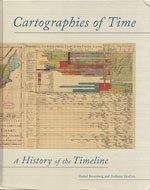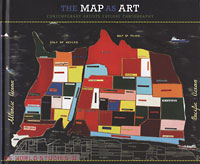Off the Map
Two new books survey cartography, history, and modern art By Rebecca Rego Barry
Cartographies of Time: A History of the TimelineDaniel Rosenberg and Anthony Grafton; Princeton Architectural Press; 272 pages; color illustrations throughout; hardcover without dust jacket; $50.00. |
The Map as Art: Contemporary Artists Explore CartographyKatharine Harmon; Princeton Architectural Press; 256 pages; color illustrations throughout; hardcover without dust jacket; $45.00. |
Think cartography, and a man with a quill pen and puffy pants may come to mind. Two new books from Princeton Architectural Press vanquish that image and demonstrate that cartography is alive and well in the twenty-first century.
The first book, Cartographies of Time, is a heavily illustrated and comprehensive history of time maps, from tables and charts to cartographic illustration to the linear form we now associate with the word “timeline.” In chapter one, the authors write, “Our claim is that the line is a much more complex and colorful figure than is usually thought.” The fact that Anthony Grafton, Princeton professor and author of The Footnote (1999), is the co-author of this volume comes as no surprise. His ability to instill passion in his readers for an odd little thing like a footnote or a timeline is astonishing (much like Henry Petroski’s books about bookshelves and pencils.)
After all, how many people have considered the evolution of the timeline? But, write the authors, “The timeline offered a new way of visualizing history.” The form emerged out of the ancient use of lists to synthesize information. Then, in the seventeenth century, chronologists moved away from tabular data and began to use the illustrative techniques of mapmakers, but that was short-lived. With the publication of Joseph Priestley’s Chart of Biography in 1765, the timeline was born. It would continue to evolve as the position of the chronologist was challenged by the position of the historian. The importance of studying dates (such as the exact annus mundi or the correct date of the Flood) became less important, and a more contextual timeline proliferated.
Koberger, Mercator, and Mark Twain have cameo roles in this curio of a book. The color illustrations are spectacular, particularly the pastel reproduction of Priestley’s chart from 1765, the vivid Protestant Ladder painted by Eliza Hart Spalding around 1845, John Sparks’ brilliant Histomap from 1931, and the garish History on Parade by Carleton Brown in 1936.
One wishes the book’s exterior were given the same treatment as the exquisite interior; the binding has the look and shape of a textbook. Nevertheless, for map collectors, history buffs, and the terminally bookish, Cartographies is a very special find.
The second book, The Map as Art, veers in an entirely different direction. It looks at cartography as a modern and post-modern art form through the work of 160 contemporary artists. The author writes, “In postmodern times, with all truths suspect, artists have found in cartography a rich vein of concepts and imagery to mind.”
From Salvadore Dali to Saul Steinberg, artists have created maps as a way to explore politics, culture, and the environment. As a collection of such pieces of cartographic visualization, this book is disarming, even if some of the artwork is praiseworthy and some is lackluster agitprop.
There is the compelling work of Joyce Kozloff to win us over. Her Boys’ Art series, in which she modified her son’s drawings and layered them onto military maps as a way to probe the attraction to war and aggressive play in young boys. Brazilian artist Vik Muniz’s WWW, a 2008 installation of a world map constructed of techno junk, also grabs our attention. Clodagh Emoe, an Irish artist, mapped out the Milky Way with burn holes on the pages of a 1932 edition of J.F. Wolfenden’s book, The Approach to Philosophy. Forgive her the book burning because The Approach is very cool.
It seems unfair to place the creations of these artists alongside a map of South America fashioned from clothing laid out on a mattress or a battered cardboard map of the U.S. with handwritten names.
Other prominent artists including Julian Schnabel, better known as the filmmaker who adapted The Diving Bell and the Butterfly, and Chinese artist Al Weiwei, whose World Map is constructed from 2,000 layers of cotton cloth, are featured in the book. In addition to detailed captions for most of the artwork, several long essays by Gayle Clemans highlight certain artists, such as Maya Lin. Lin’s cast silver Yangtze is a remarkable piece, but book lovers may be drawn to her altered atlases, in which she has carved away locations in a standard Rand-McNally, making a three-dimensional composition.
With 360 color illustrations, The Map as Art is indeed a handsome book. Map and modern art collectors will want it for their collections. Others may find it too provocative for the coffee table.









